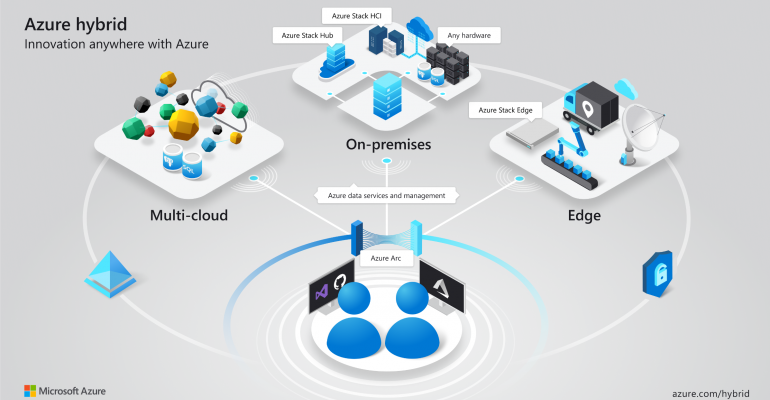Tech has no shortage of buzzy new technologies – and cutting through the hype to see what will actually impact the enterprise can be challenging. We're here to help. Starting in 2021, our contributors will give a rundown on an emerging tech and whether it'll pay off to pay attention to it. In this article, we look at Microsoft Azure Arc.
To see the other trends highlighted in our IT Trends To Watch series, read our Emerging IT Trends To Watch report.
All About Azure Arc
What is Microsoft Azure Arc, you ask? Azure Arc is an emerging hybrid cloud solution that lets users provision and manage virtually any server or database--whether it’s a legacy Linux server running on-premises, a database hosted in the Microsoft Azure cloud or even a Windows virtual machine running in a competing public cloud, like AWS--using the Azure cloud’s native tooling.
Microsoft Azure Arc does this by extending the central control plane that manages resources on Azure cloud--known as the Microsoft Azure Fabric Controller--to support resources that are hosted in other locations. To use Azure Arc, you simply deploy an agent on whichever virtual server or database you want to manage through the platform. You can then use Azure-based services like Azure Monitor, Azure Security Center and Azure Automation to control the resource.
How Long Has It Been Around?
Microsoft CEO Satya Nadella announced Azure Arc during his keynote at the Microsoft Ignite event in November 2019. The company also demonstrated the platform in action at the show.
At the time, Arc was not yet generally available. Microsoft spent the following year gradually unveiling more details about the platform.
At Ignite 2020, in November, Microsoft announced general availability of Azure Arc for managing Windows and Linux servers. Other facets of the platform, including those related to hybrid database management, remain in public preview mode. Microsoft has offered little clue to date about when to expect those other services to reach general availability.
Even before the Ignite 2020 announcement of general availability for Azure Arc servers, Microsoft was already publishing case studies that detail how companies like Ferguson and Fujitsu are using Arc--so it’s clear that the platform has already entered the wild.
Why Are People Paying Attention to It Now?
As it heads toward full general availability, Microsoft Azure Arc is making headlines primarily because of the way it differs from other hybrid cloud frameworks, which offer less flexibility when it comes to how workloads are deployed and managed.
For example, whereas Azure Stack, a hybrid cloud framework that Microsoft introduced in 2017, requires users to run their hybrid workloads on Azure Stack-certified hardware and deploy workloads using native Azure services (like Azure Virtual Machines), Azure Arc works with any type of hardware. It can also register and manage workloads that are hosted using an external service, even if the service runs on a public cloud that competes with Azure.
These differences also distinguish Microsoft Azure Arc from AWS Outposts, the hybrid cloud offering from Amazon. Outposts also requires specific hardware, and is compatible only with workloads hosted on AWS’s own cloud services.
The existing cloud offering that is most similar to Microsoft Azure Arc is Google Anthos, which lets users deploy and manage workloads running on any private data center or public cloud (not just Google’s). However, the main difference between Azure Arc and Anthos is that Anthos is designed primarily for deploying workloads that run as containers and can be managed using Kubernetes.
Azure Arc can also manage Kubernetes clusters, but it is not as Kubernetes-centric as Anthos. In addition to supporting containerized workloads, Azure Arc offers full support for conventional virtual machines. That feature gives Azure Arc a leg up in the competition for customers who want to move to a hybrid cloud architecture, but aren’t ready to convert all of their applications to run inside containers.
Who Benefits From It?
Azure Arc can simplify a broad set of IT workflows. By allowing resources outside of the Azure cloud to be provisioned using Azure tooling, Arc makes it easier to set up heterogeneous infrastructure that spans multiple data centers or cloud environments.
Likewise, Arc simplifies workload monitoring because it provides a central tool--Azure Monitoring--for monitoring servers, applications and databases that are spread across multiple locations.
Azure Arc can improve security operations, too, by allowing teams to use Azure Security Center to audit the security configurations of workloads and identify vulnerabilities, whether or not the workloads are hosted on Azure itself.
Where Can You Get It?
To get started with Azure Arc, you need an account on the Azure cloud. Once logged in, you can register the external resources that you want to manage through Azure Arc. Azure will then generate installation scripts, which you run on the objects you want to register in order to install the Azure Arc agent on them and allow the Azure Fabric Controller to manage them.
Just keep in mind that, as noted above, some of Azure Arc’s features are still in public preview mode, which means Microsoft does not yet deem them fit for production use.






